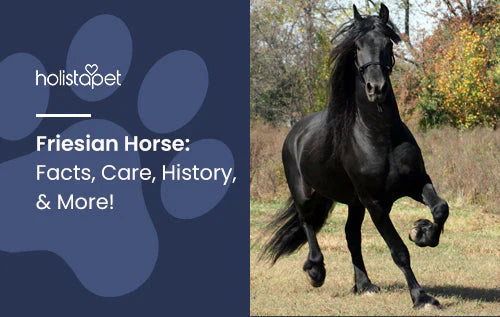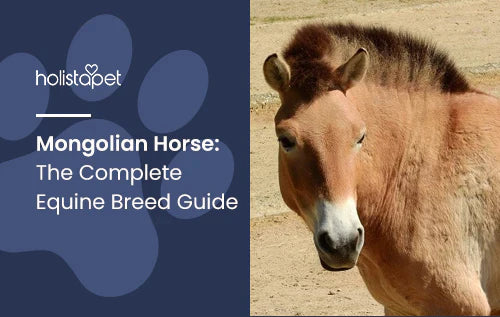If you're lucky, you've probably seen horses spotted of all kinds of colors. Horse lovers will tell you; there are multiple spotted horse coat patterns. So what makes a horse a piebald horse? The short answer: A piebald horse is white with black spots. Again, horse lovers will tell you that it gets a bit deeper than that! Let's take a closer look at what a piebald horse is, what makes a horse a piebald horse, and what types of horse breeds can have the piebald pattern!
What Does Piebald Mean?
Merriam-Webster Dictionary has some (slightly confusing) definitions of piebald. The first one: Composed of parts out of place. The second: Of different colors. Still confused? Don't worry, let's get into it some more. The word "piebald" originates from a combination of "magpie" and "bald," basically meaning "white patch" or "white spot." It's a reference to the black patches on the magpie's black and white feathers.
For animals, piebald is a multi-colored pattern with unpigmented spots (white) on a pigmented background of hair, feathers, or scales. The animals with this pattern include birds, cats, cattle, dogs, horses, pigs, and snakes. There is no specified pattern for a piebald coat. Some piebald animals appear to have symmetrical markings. Some piebald animals barely have any white background left.

What is a Piebald Horse?
When it comes to horses, a piebald horse is an exclusively black horse with white spots. British English uses this term the most often. In North American English, piebald horses are sometimes called "pinto." The piebald pattern occurs due to genetics. The horse is born with a black base coat and then a genetic makeup that codes for one of these coat markings: Tobiano, overo, or tovero.
Tobiano is described as a "black horse with patches where the black was removed." Tobiano is the result of a dominant gene, creating large white spots with rounded edges. These spots are found on the horse's body and legs. The head will be the same color as the base coat and does not have any white markings.
The overo pattern doesn't always show, and the pattern itself isn't as strict. There are a few patterns within the overo category. But overall, the white markings don't cross over the horse's back between the withers and tail. The white is irregular without clean, clear edges. There can even be some fading.
Tovero is a mix of the tobiano and overo patterns. These horses have a high majority of white markings and very little color. Their mouths are usually black, and the sides of their face and around their ears and forehead. You'll see a spot on their chest and then smaller spots across their torso and around the base of their tail.
Is a Piebald a Horse Breed?
Nope! Piebald is a color pattern, not a specific breed. Multiple horse breeds have the piebald pattern.

Which Horse Breeds are Piebald?
So what types of horses come in the piebald pattern? Here are the horse breeds that often have this black and white pattern.
Gypsy Horse
The Gypsy Horse comes in a variety of coat patterns, including piebald. This horse is recognizable due to its heavy feathering at the knees and hocks. They also have a long, full mane and tail (more hair than most horse breeds). They are shorter than a typical draft horse but have a broad build capable of pulling carriages and caravans.
While pulling caravans was the Gypsy Vanner Horse's original purpose, the breed has gained popularity in shows and driving competitions, as well as pulling carriages for pleasure. The Gypsy Horse's laid-back temperament this horse one ready to ride, especially for heavier riders.
Welsh Cob Horse
The Welsh Cob and Welsh Pony are tough and adaptable. They were originally draft horses that pulled heavy loads, including working in coal mines and hauling military equipment. They are popular for trail riding but are featured in dressage competitions. While smaller than most horses, the Welsh Cob Horse can withstand harsh climates and are surprisingly strong. You can find Welsh Cob Horses on the farm or used as racers and jumpers. They are also used in show rings thanks to their flashy appearance, including a striking piebald pattern.

Drum Horse
At 2,000 pounds, this is a large, strong, and powerful horse. It's often used in processions and parades because they can easily handle carrying 300 pounds. The Queen's Household Cavalry performance features The Drum Horse for their impressive prowess. While a bit intimidating in size, the Drum Horse is surprisingly good-natured.
They have a great temperament and are comfortable in large crowds. This breed is known to be docile and tolerant. It's easy to work with the Drum Horse, making them great for events and families. The Drum Horse comes in a variety of colors, but piebald is the most popular coat.
Marwari Horse
The Marwari Horse is slim but large, usually weighing between 750 and 1,000 pounds. They come in a variety of patterns, but piebald is one of the most favored. But what makes this horse recognizable are its ears, which are curved with the tips touching! This is a somewhat rare breed that's mostly found in India, although it's bred elsewhere.
Thanks to the breed's agility and stamina, the Marwari Horse often appears in parades and other ceremonies like dressage and polo. They are built for the desert, with a bone angle that makes them slower but more comfortable than other horses.
Dartmoor Pony
Native to Dartmoor, this pony spent hundreds of years roaming the land in the Middle Ages. This resilient and adaptable breed is now commonly found on horse farms. They serve many jobs, including hauling heavy loads and competing in riding, jumping, and dressage events. This pony is quite athletic and has a warm temper that makes it perfect for families and children.
The Dartmoor Pony ranges in size from 45 inches to 50 inches, weighing around 440 pounds. While not large in stature, this pony is muscular and has a strong frame perfect for riding.

Are Piebald Horses Rare?
No! There are some species out there where the piebald pattern is rare. This includes the deer, where only one out of 1,000 are piebald. Nonetheless, piebald horses are quite common. Many breeds include the piebald pattern.
What Are the Differences Between a Piebald, Skewball, Paint & Pinto Horse
There are also horses with patterns that define them as either a skewball, a paint, or a pinto. And while sometimes interchangeable, each of these patterns has different specifications.
Skewbald Horse
Unlike piebald horses, skewbald horses don't only come in black and white. Skewbald horses are white with a brown base, palomino, roan, bay, or chestnut. Skewbald is any white and color combination that isn't piebald (black).
Paint Horse
A Paint Horse is any breed of horse in the United States from quarter horse or Thoroughbred ancestry. These horses bolster a white coat with irregular, broad markings. Then, their parents are registered with the American Paint Horse Registry and have a stock-type body.
Pinto Horse
Pinto comes from the Spanish word for "painted." A Pinto Horse is white with patches of color and is any color. The patches are large. Any breed can have a spotted pinto coat pattern.
Final Thoughts - Piebald Horse
A lot of people automatically think that a piebald horse is a breed. But it's a genetic coat pattern. And it's quite common (even preferred) that many piebald patterns exist. This includes the Drum Horse and the Gypsy Horse. Both unique breeds share a similar coat pattern! Piebald Horses are not uncommon. In fact, you'll see them quite often. Because of their vibrancy and beauty, this bold and brilliant coat pattern gets love from all horse fanatics, new and old.







![Probiotics For Dogs [Soft Chews] - HolistaPet](http://www.holistapet.com/cdn/shop/files/Probiotic-Infographic-1_472d7a29-e30c-435a-9638-1365d8c3a9f9.jpg?v=1725384841&width=104)


























Leave a comment
All comments are moderated before being published.
This site is protected by hCaptcha and the hCaptcha Privacy Policy and Terms of Service apply.